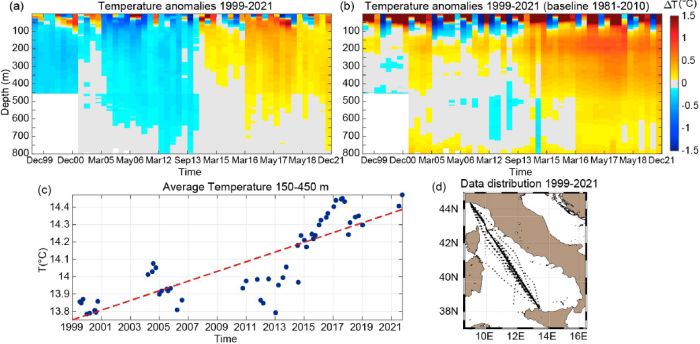
According to a study published in the journal Advances in Atmospheric Sciences, in 2021 ocean temperatures set a new record, reaching the hottest values ever measured for the sixth consecutive year; and, even more alarming is the situation of the Mediterranean Sea, which is confirmed as the fastest warming basin. The article Another record: Ocean warming continues through 2021 Despite La Niña Conditions is authored by an international team of 23 researchers from 14 institutions (including Simona Simoncelli of INGV, the National Institute of Geophysics and Volcanology, and Franco Reseghetti of ENEA, the National Agency for New Technologies, Energy and Sustainable Economic Development) and was carried out using data available on 31 December 2021, but also contains a review of previous years, based on new knowledge acquired in the meantime.
Researchers point out that the change in the heat content of the oceans in 2021 is equivalent to the energy that would be obtained by exploding seven atomic bombs every second for the duration of the year. And the new record, they warn, was reached despite the fact that 2021 saw the occurrence of the phenomenon known as La Niña, which helped limit warming in the Pacific Ocean.
For the Mediterranean, the alarming results illustrated in the study are complemented by those of temperature monitoring in the Ligurian and Tyrrhenian Seas, resumed in 2021 as part of the INGV MACMAP project, in which ENEA is participating. Since 1999, using commercial ships that sail the route between Genoa and Palermo, temperature data have been acquired that have made it possible to analyse thermal variations over time. A key partner in this activity is the Italian shipping company GNV S.p.A. (Grandi Navi Veloci) from whose ships the probes measuring temperature are launched.
“It is very important to note that the ocean absorbs just under a third of the CO2 emitted by humans, but warming waters reduce the efficiency of this process, leaving a larger percentage in the atmosphere. Monitoring and understanding how the thermal and CO2 components evolve in the ocean waters, both individually and in synergy, are very important to arrive at a mitigation plan that respects the objectives approved to limit the effects of climate change – underlines Simona Simoncelli of INGV – For example, as a result of the warming of ocean waters (leaving aside the contribution of glacier meltwater), the volume and therefore the sea level is increasing, with dramatic repercussions for Pacific atolls and island states such as the Maldives, but also for our coastal areas. In addition, ever warmer ocean waters are creating the conditions for increasingly violent and numerous storms and hurricanes, combined with periods of extreme heat in ever larger areas. And, all this, without considering the biological effects: warmer water is less rich in oxygen affects the food chain, just as water with higher acidity has even more severe effects on living things.”
“During the last data collection campaign, in mid-December 2021, I was first disconcerted and then increasingly discouraged by the data that appeared on the monitor of the acquisition system – says Franco Reseghetti of ENEA. In the Tyrrhenian Sea I found the isotherm T = 14°C almost always below 700 m, sometimes even around 800 m, depth values that surprised me. In practice, an area deeper than in the past has started to warm up in an evident way. I checked these December data at length with Simona Simoncelli, also looking for confirmation in datasets obtained from other measuring instruments in the same area and in the same period. But unfortunately our results were in good agreement with the others, and the only conclusion was: there is a new record (although we could have happily done without it).”
“This warm water has started to ‘invade’ the Tyrrhenian Sea from the south, starting from the Egadi Islands and the north-west coast of Sicily, and has continued northwards, affecting an increasingly wide area of sea at increasing depths. Unfortunately,” continues Reseghetti, “we are not able to provide forecasts for 2022, although the path taken by the Mediterranean Sea in recent years seems fairly clear, with ever-increasing amounts of energy present in its waters that remains available for interaction with the atmosphere, increasingly giving rise to extreme weather episodes such as heat waves and violent precipitation phenomena previously unknown in these areas. The year 2021 has been a manifestation of all this: the heat in Sicily in August, the rain in Liguria, the ‘medicanes’, the Mediterranean hurricanes at the end of November still in Sicily, just to give an example.”

More specifically, the time series of temperatures in the Mediterranean show more intense increases than those observed at the same intermediate depths in other areas of the global ocean.
“Since spring 2013, we observe a progressive warming in the layer between 150 and 450 m depth (but temperature values are also increasing at greater depths), with an even more evident growth between 2014 and 2017, followed by a slight decrease in 2018-2019 and a further rise in 2021,” Simona Simoncelli points out. “For the Tyrrhenian and Ligurian Seas, the temperature variation over the period 1999-2021 was 0.028°C/year, consistent with what was recorded in the Strait of Sicily by CNR instrumentation that has been acquiring values since 1993. In their data the temperature increase is estimated to be 0.026°C/year over the whole period, but with a growth of 0.034°C/year after 2011. In our data as a whole, the average temperature change in the 150-450 m layer is about 0.6°C (going from 13.8°C to 14.4°C)“.
“This further warming, which can be seen as an indicator of continuing climate change, has come, ironically, at the end of the first year of the “Decade of the Sea” (https://decenniodelmare.it/), the initiative launched by the United Nations to mobilise all sectors of civil society and promote a radical change in the way we study and manage the ocean, for a truly sustainable development that preserves a good environmental status of the ecosystem and all the resources that the ocean provides us with” conclude Simoncelli and Reseghetti.



































